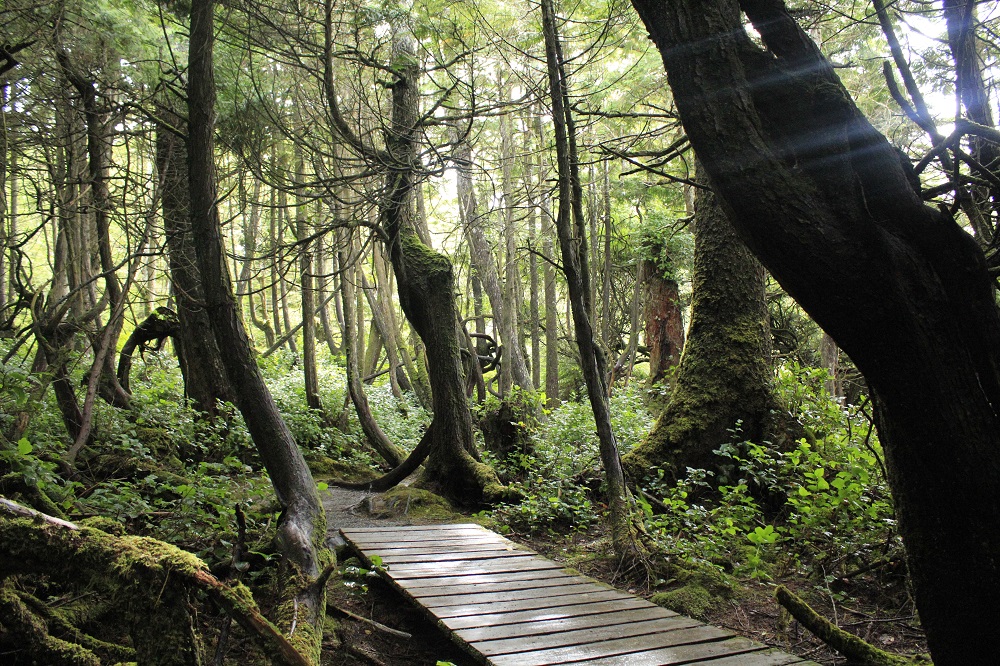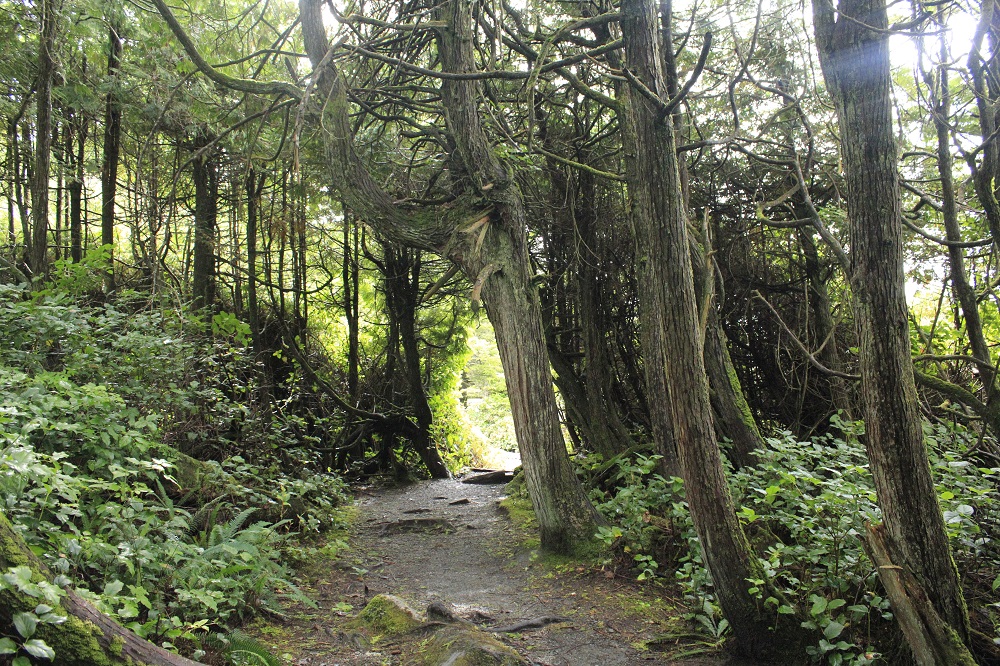
The West Coast and in particular, Botanical Beach and the adjoining Botany Bay are quite beautiful. It is part of a much larger park. The two beaches are incredible.
San Juan Park covers a large portion of southwest Vancouver Island. The area became a provincial park in 1989. Juan de Fuca Provincial Park on the west coast of Vancouver Island is a wonderful park, it offers some incredible hiking along the 47 km trail that runs between Botanical Beach and China Beach. You can hike into some of the beaches that have day trails to them where you can view the roaring surf and just possibly, see whales just offshore. Juan de Fuca Provincial Park gives an opportunity to view these large marine mammals. The best time to see Grey whales is during their migration along our coast in March and April. Seals and sea lions can also often be seen playing offshore.
There are four main areas in the park: the China Beach Campground, the Juan de Fuca Marine Trail, the China Beach day-use area, and Botanical Beach. All these beaches are just incredible.

The beaches at both botany bay and botanical beach are full of a wide variety of sea life. Both plant and animal life is in abundance, and each has adapted to contend with the variable conditions found here. Please just look, do not disturb the sea life or take any from the beach.
Black bears and cougars can also be present at any time. Black bears can become used to feeding on garbage, so to avoid teaching bears about trash, please pack out what you pack in. Cougars normally avoid people and are rarely seen, but please leave pets at home if possible and watch over young children. Do not feed the bears, remember, a fed bear quite often becomes a dead bear when they learn that humans mean food. A bear becomes a problem when they get accustomed to human food and garbage and problem bears are quite often put down to avoid problems.
The trail between Botany Bay and Botanical Beach is an incredible walk through a forest of windswept and twisted trees, it’s a beautiful place, a place of wonder. This trail is typical of most west coast beach locations, the trees are formed into contorted shapes by the winds. Every time l walk this trail, l am amazed at its beauty, it is a fascinating hike. A hike that all should do at least once in a lifetime.

Visit here in the winter for some incredible winter storm vistas but dress warm and wear rain gear as this is a rain forest. The winter storms on the West Coast are something to see, winds can blow so hard that you can barely stand up and this is when you see the most daring of the surfers, out in the huge waves, grinning like cats chewing bumblebees, having the time of their lives.
Botanical Beach once was the location of the botanical beach research station. The area brought Dr. Josephine Tildon, it was a perfect location for the University of Minnesota’s marine station that she had built-in 1900. The center was created through the efforts of both Professor Conway MacMillan and Dr. Tilden, they were so dedicated to getting it created and operating that they would even help fund its operation out of their own salaries.

This was the first marine research station in the Pacific Northwest. The site involved two school buildings and a two-story botany laboratory, there was accommodation for up to 80 students and researchers. They came from all over the world to study here under Dr. Tilden. The abundance of sea life drew them here. They even discovered a new kelp species that was named Renfrewia Parvula but is more commonly called Lamaria Ephemera.
This was quite the project, it was the turn of the 20th century and travel on Vancouver Island’s west coast was very difficult. The University of Minnesota’s Department of Botany helped Dr. Tilden set up the research station just west of Port Renfrew, the research center ran from 1901 to 1907. Students journeyed here to study sea life. To get here, they would travel from Victoria to Port Renfrew by steamer, then traverse some very steep, muddy, and narrow trails to the station. There was talk about building a better road to the bay from Port Renfrew, but it never got built and this all but sealed the fate of the station, it was closed in 1907. Since then, the area has been used for research by a number of universities in BC and Washington.

The trail between Botanical Beach and Botany Bay is an incredible walk through a forest of windswept and twisted trees, it’s a beautiful forest walk and the beaches between the two areas is a wonder to behold, truly a place of awe. I can fully understand why Dr. Tilden set up her research station here.
When you are hiking in the area, you can still see remnants of the buildings sticking out of the West Coast rainforest. There is a lot of history here, but you need to look closely as the West Coast rainforest is claiming the land back once more. The park was established on April 4, 1996. It is called the Juan DE Fuchsia Provincial Park. The park runs from China Beach Park through Loss Creek Park and Parkinson Creek Park right up to Botanical Beach Park. The Juan DE Fuchsia Marine Trail connects all these parks, it is a rugged 47 km long popular hiking trail.

The beaches at both botany bay and botanical beach are full of a wide variety of sea life. Both plant and animal life is in abundance, and each has adapted to contend with the variable conditions found here. But be careful not to get caught by rising tides in some cliff areas, or you may be scrambling to get back.
Black bears and cougars can also be present at any time. Black bears can become used to feeding on garbage, so to avoid teaching bears about trash, please pack out what you pack in. Cougars normally avoid people and are rarely seen, but please leave pets at home if possible and watch over young children.
To me, it is one of the prettiest places on the coast of Vancouver Island.